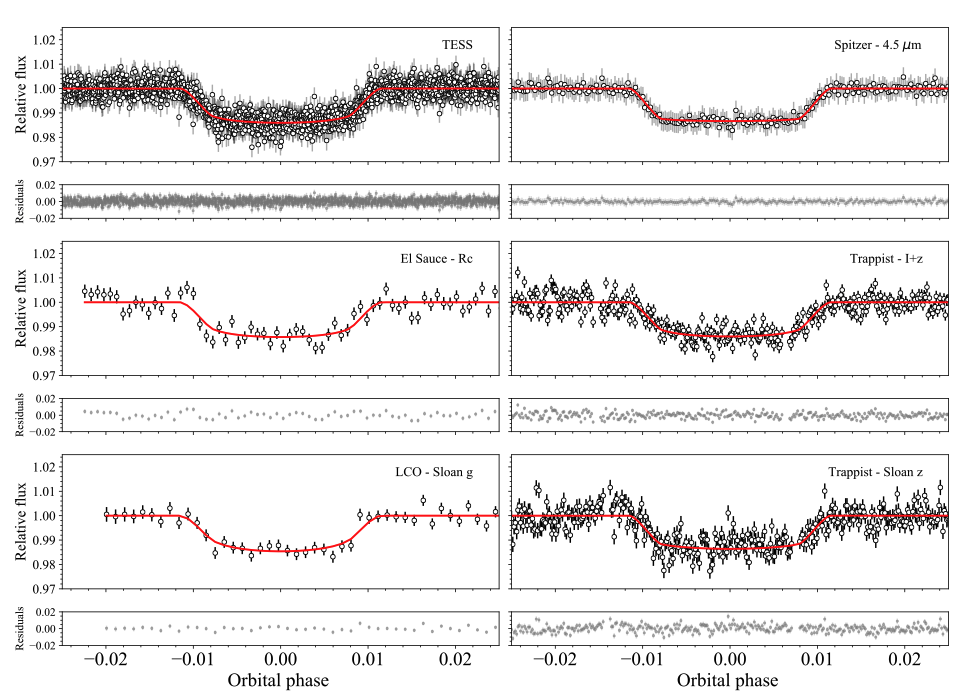STATUS UPDATE: Orbit 2 of Sector 38 is now available to download as a TICA product from MAST
Welcome TESS followers this weeks news bulletin in which we look at three papers from the archive,
TOI-674b: an oasis in the desert of exo-Neptunes transiting a nearby M dwarf (Murgas et. al., 2021) :
In this paper the authors examine data from TESS, Spitzer, HARPS, and ground-based facilities, to establish the physical properties of TOI-674b - a planet transiting a 14.2 V-band magnitude M-dwarf star known as TIC 158588995.
The authors determine that TOI-674b is a low-density super-Neptune, and that the host star has a M2V spectral type with a mass of 0.42 M⊙, radius of 0.42 R⊙, and effective temperature of 3514 K. The system itself is approximately 46 pc away.
Utilizing light curve and radial velocity measurements, a circular orbit model was fit through which an orbital period of 1.98 x 10-6 days was calculated, in addition to a planetary radius of 5.25 R⊕, and a mass of 23.6 M⊕. The density of the planet is therefore estimated as 0.91 g cm-3. A non circular orbit fit produced similar results.
The mass and radius of the planet indicates that it is one of the largest and most massive super-Neptunes around an M-type star known to date.
Visible-light Phase Curves from the Second Year of the TESS Primary Mission (Wong et al., 2021) :
Using TESS year 2 data, the authors of this paper carried out a systematic study of full-orbit phase curves for known transiting systems in the northern hemisphere. Fifteen transit systems were selected and seven had statistically significant secondary eclipses and day-night atmospheric brightness modulations, these were: HAT-P-7, KELT-1, KELT-9, KELT-16, KELT-20, Kepler-13A, and WASP-12. Two of the seven, KELT-9b and WASP-12b, have small eastward dayside hotspot offsets. An additional three, KELT-1, Kepler-13A, and WASP-12, have phase-curve variability which can be attributed to the tidal distortion of the host star.
Spitzer data were combined with that from TESS to compute the dayside brightness temperatures of the planets, the TESS geometric albedos, Bond albedos, and the phase integrals. Using the new albedo values the trend between the dayside temperature and the geometric albedo for planets with 1500<Tday<3000 K, was confirmed.
A more detailed study was conducted for Kepler-13Ab - please see the paper for more details.
Unveiling the multiple periodicities of the cataclysmic variable LS Cam (Stefanov et al., 2021) :
LS Cam is an intermediate polar cataclysmic variable (CVs). Some CVs have quasi-periodic changes in brightness with periods slightly shorter or longer than the orbital period - these are called superhumps. Superhumps are thought to be a beat period of of the orbital period and the apsidal or nodal motion of the disk, but the exact cause remains unknown.
Using TESS 120 second cadenced data from sectors 19, 20, and 26, the authors examined LS Cam. Focusing on Sectors 19 and 20, a periodogram analysis was performed, using the Lomb-Scargle method. The resulting power spectrum indicated four significant periodicities, the orbital period of 0.1424 days, a super-orbital variation of 4.053 days, a permanent negative superhump of 0.1375 days, and when looking at Sector 26 a positive superhump of 0.155 days.
Taking relations from the literature, the mass ratio and masses of the two components are estimated as 0.24, and 1.26, and 0.30M⊙ respectively.

Fig. 1: Taken from Murgas et. al., (2021). TOI-674b space and ground-based transit light curves after removing systematic noise affecting the data. The best circular orbit model fit is represented by the red line and below each panel the residuals of the fit are shown.

Fig. 2: Taken from Stefanov et. al., (2021). The two sets of TESS photometry (black dots) and errors (gray lines). The corresponding periodograms are below each light curve.